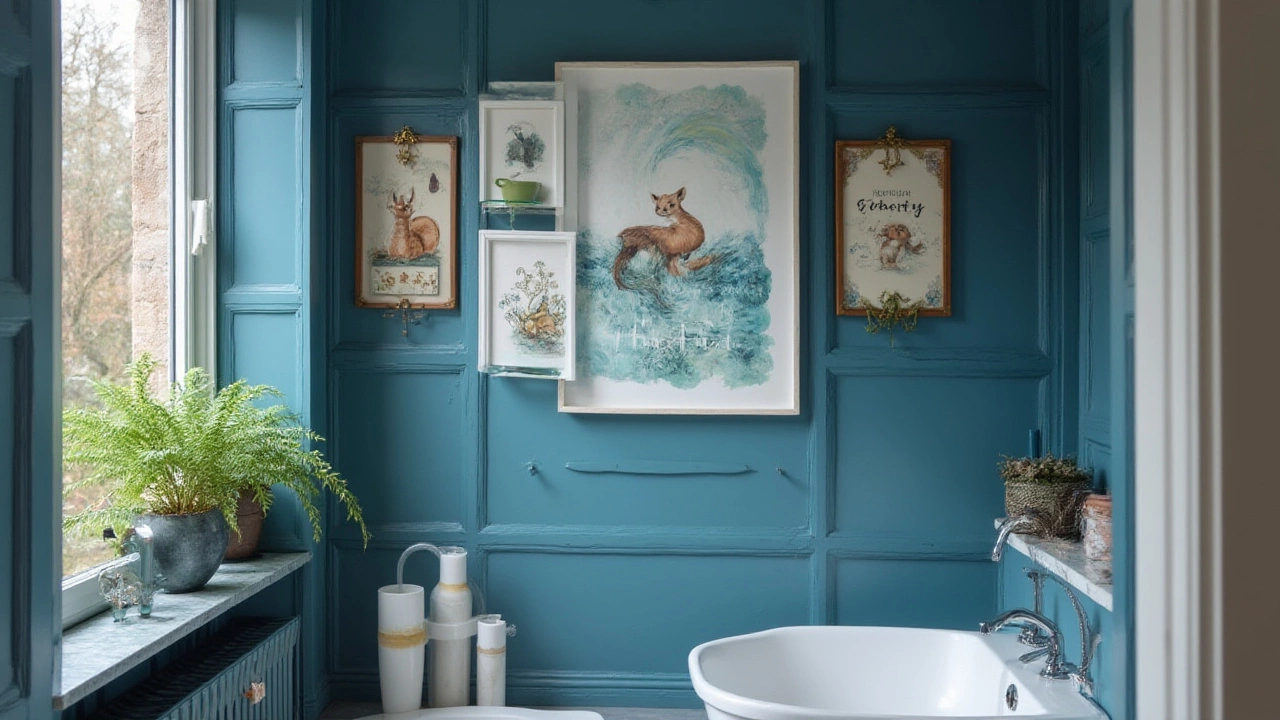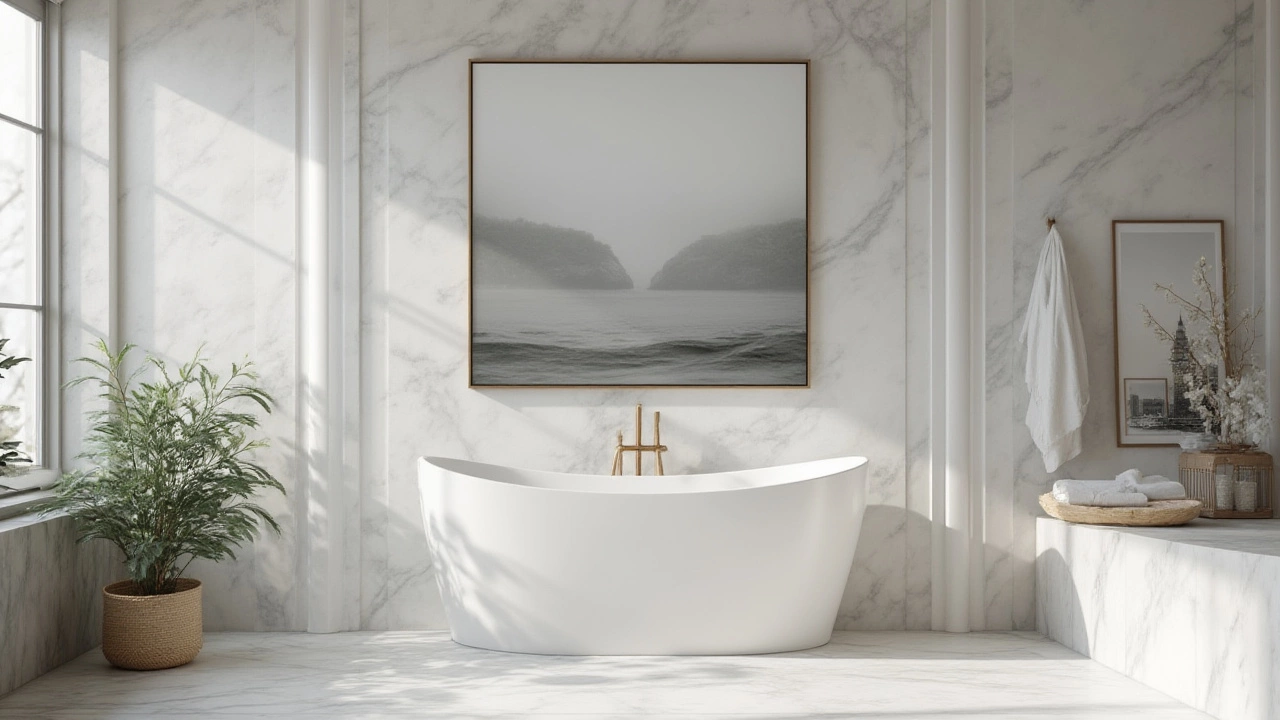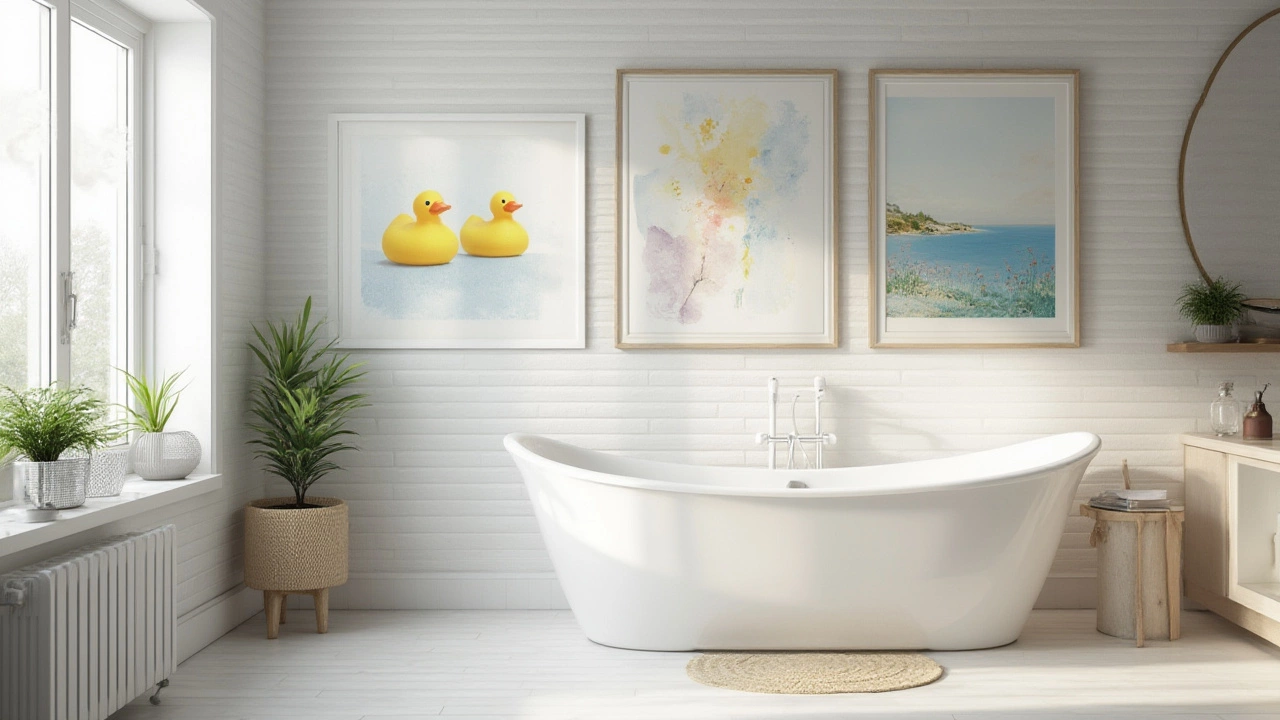Who even decided that bathrooms should be boring? These days, people care about what they see while brushing their teeth or soaking in the tub—and yes, that includes the art on the walls. Art in bathrooms isn't just about hiding plain tiles or filling up emptiness. The right picture can change the whole mood of a bathroom, make tiny spaces feel bigger, and even become a fun surprise for guests. There’s an actual fact out there: a survey by HomeAdvisor showed that over 56% of homeowners add décor or art to their bathrooms within two years of moving in. But here comes the tricky part—not every kind of picture is made for steamy, towel-draped rooms. You wouldn't want your favorite print to peel after one hot shower. So what actually works in bathrooms? You’ll be surprised how much choice you truly have, as long as you play it smart.
The Best Types of Pictures for Bathrooms and Why They Work
Bathrooms are their own unpredictable little worlds. One moment, they’re dry and calm. The next, they’re full of steam and humidity, especially after a long shower. Whatever picture you hang needs to handle these wild swings. The gold standard here is moisture resistance. Professional designers often talk about the "splash zone"—the wall area near bathtubs and sinks that sees the most water. Anything that goes near it should be tough. So, what types of art hold up best?
Let’s start with materials. Prints on acrylic, aluminum, or even glass are prime picks. These materials are almost immune to warping or moisture damage, according to interior designers at Houzz. If you’re set on a photograph, try printing it on metal: the colors stay bright, and the surface is easy to wipe down. Canvas can work, but only if it’s professionally sealed—otherwise, humidity will sneak in and do its worst.
There’s more to it than just the print. Pay attention to framing, too. Metal, plastic, or resin frames always beat traditional wood frames unless the wood is heavily sealed. It’s easy to get fooled by so-called "bathroom-safe" frames that actually contain cardboard backings; those can grow mildew over time. Surprisingly, some of the safest choices include no frame at all: floating acrylic panels or laminated prints that hang directly on the wall.
The types of images people pick are just as important as the materials. Botanicals are a classic. Think muted leaves, ferns, even succulents. They feel serene and fresh—plus, they won’t go out of style next year. Abstract pieces also shine, especially in minimalist bathrooms. They add personality without making the space feel crowded, and you can easily swap them as tastes change. For powder rooms or tiny half baths, playful illustrations or cheeky quotes are having a moment. The kind you see in trendy restaurants—funny, slightly unexpected, and always a conversation starter.
If you want something really special, look towards vintage prints. Art deco and mid-century designs look surprisingly cool in bathrooms, giving even boring rental spaces a quirky twist. Maps—especially old city maps or blueprints—can be the missing piece that makes your bathroom unique. And don’t forget about family photos, but only if you print them on waterproof material. You’d be surprised how personal a space can feel when there’s a happy memory hanging by the mirror.
Here’s a quick overview table for easy comparison of popular bathroom art types and their key features:
| Type of Picture | Best Material | Durability | Decor Style |
|---|---|---|---|
| Botanicals | Acrylic/Metal Print | High | Classic, Spa-like |
| Abstract Art | Sealed Canvas/Metal | Medium/High | Modern, Minimalist |
| Vintage Prints | Laminated Paper/Metal | Medium/High | Retro, Eclectic |
| Family Photos | Metal Print/Acrylic | High | Personal Touch |
| Quotes/Funny Prints | Laminated Poster | Medium | Contemporary, Whimsical |
This is just a snapshot of what’s possible. The real test is how the image makes you feel. If it makes you smile whenever you’re shampooing, you’ve picked a winner.

How to Choose Art for Your Specific Bathroom
It all comes down to size, light, and vibe. Start with the basics: measure your walls. Tiny bathrooms can feel cramped if you use oversized art, while gigantic empty walls make tiny prints look lost. Find the sweet spot—art that fills 2/3 of the wall width tends to look balanced in bathrooms, especially behind toilets or above bathtubs. If you want to get this just right, cut a piece of paper or cardboard to the size you’re considering and tape it up for a day. If it feels good every time you walk in, you’ve nailed it.
Lighting swings things a lot. Bathrooms with natural light allow nearly any art, but if your only light is overhead or bulb-based, stick to pictures with bold colors or strong contrast. Art with lots of white or pale space can get washed out under harsh lighting. For windowless rooms, metallic prints bounce what little light there is and make the place feel less like a cave.
There are also psychological tricks. A study by the American Institute of Architects found that people felt most relaxed in bathrooms featuring nature-based or blue-green art—something about those colors mimics water and sky, tricking your brain into chill mode. If relaxation is the goal (think master bathrooms or spa-like setups), go heavy on calm landscapes, flowing abstract shapes, or seashell close-ups.
On the other hand, powder rooms allow you to break all the rules. Because nobody spends a long time in these small spots, you can go bold—wild patterns, neon art, even a collage wall. Art in guest bathrooms can echo your sense of humor. A 2024 Houzz trends report listed "statement art in powder rooms" as one of the most popular upgrades of the year.
Children’s bathrooms are a whole different game. Here, sturdy, wipe-clean art is king. Pick playful illustrations—think whales, rubber duckies, or cartoonish rainbows. Parents report that illustrated step-by-step bathroom routines (like a chart for handwashing) cut down nagging by up to 70%, according to the Parenting Institute’s recent survey. Laminate these for durability.
If you’re short on wall space, get creative. Try hanging smaller framed prints in a cluster around the mirror or above the towel rack. Long, narrow art fits surprisingly well above doors. Even shelves can hold leaning prints—just swap them out when you’re ready for a new look.
Another overlooked factor: accessibility. If someone in your home uses a wheelchair, pictures should hang a bit lower than standard (centered at about 54 inches from the floor instead of the usual 57–60 inches). Little details like this make the bathroom welcoming for everyone—small changes, big difference.
Here’s a quick cheat sheet of do’s and don’ts for choosing bathroom art:
- DO choose art that makes YOU happy—bathrooms are personal spaces
- DO pick moisture-resistant materials
- OK to use bold colors, especially in small or dull spaces
- Group several small pieces rather than one huge one if you prefer variety
- DON'T put valuable or irreplaceable originals in bathrooms—humidity wins every time
- DON'T forget to check the back of the frame for cardboard or unsealed wood (humidity magnets!)
- DON'T hang anything directly over a frequently-used tub if you can help it—mold loves warm, damp air
Create your own rule: If the print survives three showers without fogging or drooping, it's probably good for the long haul.

Tips and Tricks for Hanging and Caring for Bathroom Pictures
So you’ve picked your art—now comes the not-so-fun part: hanging it so it actually stays up and looking good, even after months of showers and humidity. This is where a few little-known tricks can save your favorite new piece from disaster.
First up: hardware matters. Self-adhesive hooks or strips (like Command Strips) work in most bathrooms, but only on squeaky-clean, dry tile or painted walls. Skip them for textured surfaces or places that get splashed—humidity plus gravity can send even sturdy hooks crashing down. For heavy or large art, drill in a plastic or stainless steel anchor. You don’t want rust creeping in behind your picture.
Hanging height works a bit differently in bathrooms than living rooms. The rule-of-thumb is to center art at 58 inches from the ground for average eye level, but above toilets or towel rods, art naturally sits higher. If you’re hanging above the toilet, leave 6–12 inches between the top of the toilet and the bottom of your frame. Over the tub, the safest minimum is 8 inches above the top edge, both to dodge splashes and to keep your frame clear of steam zones.
Caring for bathroom art sounds fussy, but most modern prints are low maintenance. Wipe acrylic or glass prints with a microfiber cloth. For metal prints, a quick swipe with a soft cloth does the trick. If droplets or fog build up, gently dry the surface—don’t wait for water to evaporate or you'll end up with spots. Try to avoid harsh cleaners; they can dull shiny surfaces or eat up protective films.
Framed art needs a little more TLC. Every couple months, check the back for moisture or mildew. If you spot anything, remove the backing and let the print air dry in a warm, dry spot. This simple step can double the life of your bathroom art. Want your frames airtight? Add a thin bead of clear silicone sealant behind the edge of the glass where it meets the frame. It’s a pro tip that stops fog and moisture in their tracks.
If you live in a climate where humidity is always high—think Florida or Southeast Asia—run the exhaust fan every time you shower, and leave the door ajar afterward. This isn’t just for your art—it keeps everything in the bathroom healthier, mold-free, and smelling better.
Want to change your art with the seasons or your mood? Look for easy-swap frames or art sleeves. These let you refresh the bathroom without new holes or sticky residue. Nearly two-thirds of people who update their bathroom art each year use these quick-change frames, according to a 2025 survey by Apartment Therapy.
If you’re going completely art-free in your bathroom because you think it isn’t practical: think again. Waterproof wall decals are a fun alternative, especially for renters or commitment-phobes. They cost less, peel off easily, and come in every pattern under the sun. There’s even a trend for giant "peel-and-stick murals" that make a tiny bathroom feel like a tropical escape—or a spaceship, depending on your taste.
To wrap up, the best bathroom pictures are those you genuinely love, made from the right materials for the job. The little details—like humidity-safe printing, clever framing, and placement tricks—make all the difference. Whether you favor spa-like neutrals, bold and cheeky graphics, or serene abstract art, there’s a world of options for turning your bathroom into a space that feels just as designed as any other room in your home. So next time you step into your bathroom, look around. Is it missing that spark? Now you know exactly how to fix it.


